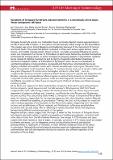Por favor, use este identificador para citar o enlazar a este item:
http://hdl.handle.net/10261/125162COMPARTIR / EXPORTAR:
 SHARE
BASE SHARE
BASE
|
|
| Visualizar otros formatos: MARC | Dublin Core | RDF | ORE | MODS | METS | DIDL | DATACITE | |

| Campo DC | Valor | Lengua/Idioma |
|---|---|---|
| dc.contributor.author | Camuera, J. | es_ES |
| dc.contributor.author | Alonso-Zarza, Ana María | es_ES |
| dc.contributor.author | Rodríguez-Berriguete, Álvaro | es_ES |
| dc.date.accessioned | 2015-11-17T11:08:07Z | - |
| dc.date.available | 2015-11-17T11:08:07Z | - |
| dc.date.issued | 2015-06 | - |
| dc.identifier.citation | Abstract Book of 31st IAS Meeting of Sedimentology, 22-25 June, 2015, Kraków, Poland, p. 105. | es_ES |
| dc.identifier.uri | http://hdl.handle.net/10261/125162 | - |
| dc.description.abstract | Tortajada fluvial-tufa system is a freshwater fluvial carbonate deposit located approximately 6 km NE of Teruel (NE of Spain), in the eastern and tectonically active margin of the Teruel Basin. This margin was active during Neogene and Quaternary because of the movement of Concud and Teruel faults. The preserved deposit is divided in three main zones: upper terrace, lower terrace, and middle cascade-ponds. These terraces, cascades and ponded/shallow lacustrine areas, are composed of six facies: 1) framestone of stem facies formed by calcified macrophyte and bryophyte hanging stems, or some macrophytes growing upward, 2) phytoclastic rudstone facies consist of calcified macrophyte and bryophyte fragments distributed chaotically in micritic/microsparitic matrix, 3) framestone of bryophyte (moss) facies is a phytoherm of calcified bryophytes in living positions, 4) peloidal and filamentous stromatolite facies are slightly undulated stromatolite bodies with internal peloidal layers and organic filaments from which stromatolites could have been formed, 5) mudstone facies made up of micritic matrix with few grains (fragments of mosses and charophytes, ostracods, intraclasts…) and, 6) conglomerate and breccia facies containing stream fluvial polymictic gravels and slope-breccias. Besides, granular and peloidal microfacies appear in various facies (mainly in stromatolites) composed of intraclastic grains (previous moss and tufa fragments) and micritic peloids. Identifiable microbial microstructures in topmost parts of almost all facies micritized previously existing crystals. All six facies are organized in three sedimentary sequences, from east to west (downstream): terrace sequence, pond sequence and cascade sequence. All sequences start from fluvial conglomeratic base, with energy of water decreasing towards the top. These sequences were dependent of paleomorphology and, therefore, conditioned by Late Pliocene and Quaternary tectonic activity. Thus, secondary faults linked to the eastern margin of extensional Teruel Basin were, for instance, responsible for the cascade sequence. Also discontinuities made in Mesozoic host-rock allowed the upwelling of groundwater. Thereby, tectonic activity played an important role in diverse episodes of the formation of this fluvial-tufa system, beginning from the initial incision and establishment of fluvial network, and finalizing on tuffaceous ponds/shallow lacustrine and cascade areas. This is reflecting in various described facies and sequences formed along different sub-environments of the system. Negative isotopic values suggest that the origin of water for the formation of Tortajada fluvialtufa deposit was both meteoric rainfall and upwelling of shallow-groundwater, consistent with other data of tufas from the NE of Iberian Peninsula. Low ranges in δ18O indicates and open system with short residence time of water. In contrast, variations in δ13C values could be related to diverse processes, such as degassing during calcite physicochemical precipitation, photosynthesis or respiration of microbes, or even different residence times of the water. In conclusion, Tortajada fluvial-tufa deposit provides important information about fluvial sedimentation and tufa development during the evolution and different episodes of the formation of Teruel Basin. | es_ES |
| dc.language.iso | eng | es_ES |
| dc.publisher | International Association of Sedimentologists | es_ES |
| dc.relation.isversionof | Publisher's version | es_ES |
| dc.rights | openAccess | es_ES |
| dc.title | Variations of Tortajada fluvial-tufa sub-environments in a tectonically active basin, Teruel semigraben, NE Spain | es_ES |
| dc.type | póster de congreso | es_ES |
| dc.description.peerreviewed | Peer reviewed | es_ES |
| dc.relation.csic | Sí | es_ES |
| dc.type.coar | http://purl.org/coar/resource_type/c_6670 | es_ES |
| item.openairetype | póster de congreso | - |
| item.grantfulltext | open | - |
| item.cerifentitytype | Publications | - |
| item.openairecristype | http://purl.org/coar/resource_type/c_18cf | - |
| item.fulltext | With Fulltext | - |
| item.languageiso639-1 | en | - |
| Aparece en las colecciones: | (IGEO) Comunicaciones congresos | |
Ficheros en este ítem:
| Fichero | Descripción | Tamaño | Formato | |
|---|---|---|---|---|
| Alonso_2_IMS 2015 Abstracts Book.pdf | 182,25 kB | Adobe PDF |  Visualizar/Abrir |
CORE Recommender
Page view(s)
227
checked on 23-abr-2024
Download(s)
106
checked on 23-abr-2024
Google ScholarTM
Check
NOTA: Los ítems de Digital.CSIC están protegidos por copyright, con todos los derechos reservados, a menos que se indique lo contrario.
